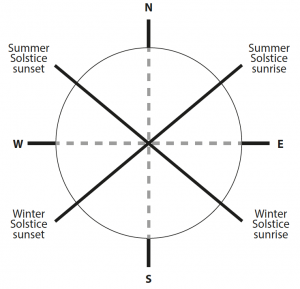The Sun Burns Brightest
Tomorrow marks the astronomical summer solstice, the day when the sun burns brightest. Whilst we may be familiar with the idea of the summer solstice being celebrated because it is the longest day, evidence indicates that its celebration formed part of a complex interaction of astronomy, society and ritual – it was far more than simply a mechanism that acted as a farmers calendar. [1]
A less popular but more enduring belief, is that the summer solstice is considered the time when the borders between this world and the Otherworld, the conditions between the living and the dead, and with the gods – became “transitory and permeable, and therefore susceptible to be crossed in both directions” [2] according to Barillari in her study ‘The Shamanic Roots of European Culture: Visions of the Otherworld and Ecstatic Battles from the Middle Ages to the Present Day’.
These ‘conditions’ were heightened at both the Summer and Winter solstices because at these two times of the year the path of the sun, the ecliptic, crosses the Milky Way forming two celestial gates, portals, where the descent and ascent of souls was believed to occur. This magico-religious tradition was known to hunter-gatherers from the Palaeolithic era 21,000 years ago [3], the ancient Babylonians in 1,300 B.C. [4] the Roman republic in 312 A.D. through to the Christian conversion.
Over time, these two gates on the path of ecliptic, which sit between two pairs of zodiacal constellations, Gemini and Taurus marking the Northern gate of the Summer solstice and Scorpio and Sagittarius marking the Southern gate became associated with just Gemini and Scorpio, overwhelmingly the symbols of solstice duality, involving birds and serpents. [5]

The Solstice orientations, if marked against the horizon form a cross, an “X” between the cardinal directions of North, East, South and West. This “X” became a common motif and arcane symbol appearing on Roman coins, where crossed spears form an “X” in the heavens, [4] on many early Christian artifacts and as I argue in ‘A Ritual Landscape Considered: Cosmography and Anglo-Saxon Ship Burials’, the famous helmet discovered at Sutton Hoo.
Arcane Landscape are preparing ‘Staverton – Wonderland of Kings: It’s Place in the Sacral Landscape of the Sandlings’ for publication this summer. Part 2 ‘Wonderland of Kings: Staverton and the Totemic Symbols of the Wuffing Kingdom’ will pick up this symbol of the “X” and how ritually planned sites formed an ensouled landscape that incorporated this cosmological world view, that was painted across the canvas of the landscape; as above, so below.
References
- McCluskey, S.C (1998) Astronomies and Cultures in Early Medieval Europe. Cambridge University Press, Cambridge
- Barillari, S.M (2017) The Shamanic Roots of European Culture: Visions of the Otherworld and Ecstatic Battles from the Middle Ages to the Present Day.
- Hancock, G (2015) Magicians of the Gods: The Forgotten Wisdom of Earth’s Lost Civilisation. Thomas Dunne Books
- Latura, G (2015) Eternal Rome: Guardian of the Heavenly Gates. Inspiration of Astronomical Phenomena VIII: City of Stars. ASP Conference Series, Vol. 501. Abbott, B.P. (ed). Astronomical Society of the Pacific
- Ogier, J. (2013) Two-Faced Solstice Symbols and the World Tree. Sources of Mythology. Ancient and Contemporary Myths. (Antoni, K, Weis, D. eds.) Proceedings of the Seventh Annual international Conference of Comparative Mythology (May 2013, Tubingen)
